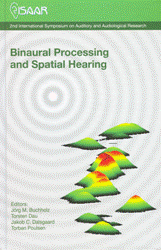Detection and identification of monaural and binaural pitch contours in dyslexic listeners
Abstract
Binaural pitch stimuli were used in several recent studies to test for the presence of binaural auditory impairment in reading-disabled subjects. The outcome of three of these studies [Dougherty et al., NeuroReport, 9, 3001– 3005 (1998); Edwards et al., Dev. Neuropsychol. 25, 321-354 (2004); Chait et al., Brain Lang. 102, 80-90 (2007)] has been contradictory: Where the former two found that a majority of dyslexic subjects were unable to hear binaural pitch, the latter obtained a clear response of dyslexic listeners to Huggins’ pitch (HP) [Cramer and Huggins, J. Acoust. Soc. Am. 30, 413–417 (1958)]. The present study clari ed whether impaired binaural pitch perception is found in dyslexia. Results from a pitch contour identi cation test, performed in 31 dyslexic listeners and 31 matched controls, clearly showed that dyslexics perceived HP as well as the controls. Both groups also showed comparable results with a similar-sounding, monaurally-detectable, pitch-evoking stimulus. However, nine of the dyslexic subjects had dif culty identifying pitch contours, independent of the stimulus used. The ability of subjects to correctly identify pitch contours was found to be signi cantly correlated to measures of frequency discrimination. This correlation may be attributed to the similarity of the experimental tasks and probably re ects impaired cognitive mechanisms related to auditory memory or auditory attention rather than impaired low-level auditory processing per se.
References
Banai, K., and Ahissar, M. (2004). “Poor Frequency Discrimination Probes Dyslexics with Particularly Impaired Working Memory,” Audiol. Neurootol. 9, 328–340.
Banai, K., and Ahissar, M. (2006). “Auditory Processing De cits in Dyslexia: Task or Stimulus Related?,” Cereb. Cortex 16, 1718–1728.
Chait, M., Eden, G., Poeppel, D., Simon, J.Z., Hill, D. F., and Flowers, D. L. (2007). “Delayed Detection of Tonal Targets in Background Noise in Dyslexia,” Brain Lang. 102, 80–90.
Cramer, E. M., and Huggins, W. H. (1958). “Creation of Pitch through Binaural Interaction,” J. Acoust. Soc. Am. 30, 413–417.
Dougherty, R. F., Cynader, M. S., Bjornson, B. H., Edgell, D., and Giaschi, D. E. (1998). “Dichotic Pitch: A New Stimulus Distinguishes Normal and Dyslexic Auditory Function,” NeuroReport 9, 3001–3005.
Edwards, V. T., Giaschi, D. E., Dougherty, R. F., Edgell, D., Bjornson, B. H., Lyons, C., and Douglas, R. M. (2004). “Psychophysical Indexes of Temporal Processing Abnormalities in Children with Developmental Dyslexia,” Dev. Neuropsychol. 25, 321–354.
Francart, T., van Wieringen, A., and Wouters, J. (2008). “APEX 3: A Multi-Purpose Test Platform for Auditory Psychophysical Experiments,” J. Neurosci. Meth. 172, 283–293.
France, S. J., Rosner, B. S., Hansen, P. C., Calvin, C., Talcott, J. B., Richardson, A. J., and Stein, J. F. (2002). “Auditory Frequency Discrimination in Adult Developmental Dyslexics,” Percept. Psychophys. 64, 169–179.
Hämäläinen, J. A., Leppänen, P. H. T., Guttorm, T. K., and Lyytinen, H. (2008). „Event-Related Potentials to Pitch and Rise Time Change in Children with Reading Disabilities and Typically Reading Children,” Clin. Neurophysiol. 119, 10 0 –115.
Hari, R., Sääskilahti, A., Helenius, P., and Uutela, K. (1999). “Non-Impaired Auditory Phase Locking in Dyslexic Adults,” NeuroReport 10, 2347–2348.
Hari, R., and Renvall, H. (2001). “Impaired Processing of Rapid Stimulus Sequences in Dyslexia,” Trends Cogn. Sci. 5, 525–532.
Hill, N. I., Bailey, P. J., Grif ths, Y. M., and Snowling, M. J. (1999). “Frequency Acuity and Binaural Masking Release in Dyslexic Listeners,” J. Acoust. Soc. Am. 106, L53–L58.
McAnally, K. I., and Stein, J. F. (1996). “Auditory Temporal Coding in Dyslexia,” Proc. R. Soc. Lond. B 263, 961–965.
Rosen, S. (2003). “Auditory Processing in Dyslexia and Speci c Language Impairment: Is There a De cit? What is its Nature? Does it Explain Anything?,” J. Phonetics 31, 509–527.
Santurette, S., and Dau, T. (2007). “Binaural Pitch Perception in Normal-Hearing and Hearing- Impaired Listeners,” Hear. Res. 223, 29–47.
Shaywitz, S. E., Shaywitz, B. A., Fletcher, J. M, and Escobar, M. D. (1990). “Prevalence of Reading Disability in Boys and Girls. Results of the Connecticut Longitudinal Study,” J. Amer. Med. Assoc. 264, 998–1002.
Wright, B. A., Bowen, R. W., Zecker, S. G. (2000). “Nonlinguistic Perceptual De cits Associated with Reading and Language Disorders,” Curr. Opin. Neurobiol. 10, 482–486.
Additional Files
Published
How to Cite
Issue
Section
License
Authors who publish with this journal agree to the following terms:
a. Authors retain copyright* and grant the journal right of first publication with the work simultaneously licensed under a Creative Commons Attribution License that allows others to share the work with an acknowledgement of the work's authorship and initial publication in this journal.
b. Authors are able to enter into separate, additional contractual arrangements for the non-exclusive distribution of the journal's published version of the work (e.g., post it to an institutional repository or publish it in a book), with an acknowledgement of its initial publication in this journal.
c. Authors are permitted and encouraged to post their work online (e.g., in institutional repositories or on their website) prior to and during the submission process, as it can lead to productive exchanges, as well as earlier and greater citation of published work (See The Effect of Open Access).
*From the 2017 issue onward. The Danavox Jubilee Foundation owns the copyright of all articles published in the 1969-2015 issues. However, authors are still allowed to share the work with an acknowledgement of the work's authorship and initial publication in this journal.


